
Four Thirds System
Encyclopedia

Olympus Corporation
is a Japan-based manufacturer of optics and reprography products. Olympus was established on 12 October 1919, initially specializing in microscope and thermometer businesses. Its global headquarters are in Shinjuku, Tokyo, Japan, while its USA operations are based in Center Valley, Pennsylvania,...
and Kodak for digital single-lens reflex camera
Digital single-lens reflex camera
Most digital single-lens reflex cameras are digital cameras that use a mechanical mirror system and pentaprism to direct light from the lens to an optical viewfinder on the back of the camera....
(DSLR) design and development.
The system provides a standard
Standardization
Standardization is the process of developing and implementing technical standards.The goals of standardization can be to help with independence of single suppliers , compatibility, interoperability, safety, repeatability, or quality....
that, with digital camera
Digital camera
A digital camera is a camera that takes video or still photographs, or both, digitally by recording images via an electronic image sensor. It is the main device used in the field of digital photography...
s and lenses
Lenses for SLR and DSLR cameras
This article is about photographic lenses for single-lens reflex film cameras and digital single-lens reflex cameras .Furthermore, the emphasis is on modern lenses for 35 mm film SLRs and for DSLRs with sensor sizes less than or equal to 35 mm .-Interchangeable lenses:The major advantage...
available from multiple manufacturers, allows for the interchange of lenses and bodies from different manufacturers. seems to cover the standard. Proponents describe it as an open standard
Open standard
An open standard is a standard that is publicly available and has various rights to use associated with it, and may also have various properties of how it was designed . There is no single definition and interpretations vary with usage....
, but companies may only use it under a non-disclosure agreement.
Unlike older SLR systems, Four Thirds has been designed from the ground up to be entirely digital. Many lenses are extensively computerized, to the point that Olympus offers firmware
Firmware
In electronic systems and computing, firmware is a term often used to denote the fixed, usually rather small, programs and/or data structures that internally control various electronic devices...
updates for many of them. Lens design has been tailored to the requirements of digital sensors, most notably through telecentric
Telecentric lens
A telecentric lens is a compound lens which has its entrance or exit pupil at infinity; in the prior case, this produces an orthographic view of the subject. This means that the chief rays are parallel to the optical axis in front of or behind the system, respectively...
designs. The size of the sensor is significantly smaller than for most DSLRs and this implies that lenses, especially telephoto lenses, can be smaller. For example, a Four Thirds lens with a 300 mm focal length
Focal length
The focal length of an optical system is a measure of how strongly the system converges or diverges light. For an optical system in air, it is the distance over which initially collimated rays are brought to a focus...
would cover about the same angle of view as a 600 mm focal length lens for the 35 mm film
135 film
The term 135 was introduced by Kodak in 1934 as a designation for cartridge film wide, specifically for still photography. It quickly grew in popularity, surpassing 120 film by the late 1960s to become the most popular photographic film format...
standard, and is correspondingly more compact. However, with the smaller sensor The Four Thirds System has crop factor
Crop factor
In digital photography, a crop factor is related to the ratio of the dimensions of a camera's imaging area compared to a reference format; most often, this term is applied to digital cameras, relative to 35 mm film format as a reference. In the case of digital cameras, the imaging device would be a...
(focal length multiplier) of about 2, and while this enables longer focal length for greater magnification, it doesn't aid the manufacture of wide angle lenses. The smaller sensor area puts it at a disadvantage against other DSLRs, especially for low light photography, and also for image quality in general. The Four Thirds system does, however, give a marked improvement over compact point and shoot digital cameras in these areas.
Sensor size and aspect ratio
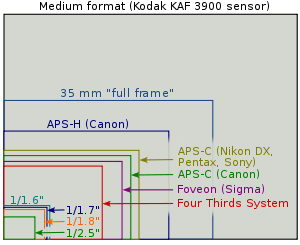
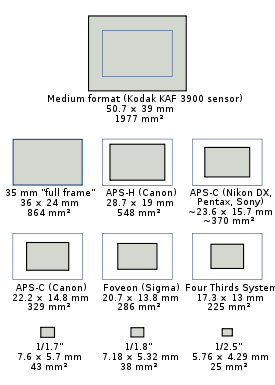
Video camera tube
In older video cameras, before the mid to late 1980s, a video camera tube or pickup tube was used instead of a charge-coupled device for converting an optical image into an electrical signal. Several types were in use from the 1930s to the 1980s...
s, which are now obsolete. The imaging area of a Four Thirds sensor is equal to that of a video camera tube of 4/3" diameter.
The usual size of the sensor
Image sensor format
In digital photography, the image sensor format is the shape and size of the image sensor.The image sensor format of a digital camera determines the angle of view of a particular lens when used with a particular camera...
is 18×13.5 mm (22.5 mm diagonal), with an imaging area of 17.3×13.0 mm (21.63 mm diagonal). The sensor's area is about 30–40% smaller than the APS-C
APS-C
Advanced Photo System type-C is an image sensor format approximately equivalent in size to the Advanced Photo System "classic" size negatives...
sensors used in most other DSLRs, but still around 9 times larger than the 1/2.5" sensors typically used in compact digital cameras. Incidentally, the imaging area of a Four Thirds sensor is almost identical to that of 110 film
110 film
110 is a cartridge-based film format used in still photography. It was introduced by Kodak in 1972. 110 is a miniaturised version of Kodak's earlier 126 film format. Each frame is , with one registration hole....
.
The emphasis on the 4:3 image aspect ratio
Aspect ratio (image)
The aspect ratio of an image is the ratio of the width of the image to its height, expressed as two numbers separated by a colon. That is, for an x:y aspect ratio, no matter how big or small the image is, if the width is divided into x units of equal length and the height is measured using this...
sets Four Thirds apart from other DSLR systems, which usually adhere to the 3:2 aspect ratio of the traditional 35 mm
135 film
The term 135 was introduced by Kodak in 1934 as a designation for cartridge film wide, specifically for still photography. It quickly grew in popularity, surpassing 120 film by the late 1960s to become the most popular photographic film format...
format. However, the standard only specifies the sensor diagonal, thus Four Thirds cameras using the standard 3:2 aspect ratio would be possible; notably newer Panasonic Micro Four Thirds models even offer shooting at multiple aspect ratios while maintaining the same image diagonal. For instance, the Panasonic GH1 uses a multi-aspect sensor designed to maximize use of the image circle
Image circle
The image circle, or circle of illumination, of a lens is the circular area in the image plane formed by the cone of light transmitted by the lens . Within this circle is the smaller circle for which image definition is acceptable, the circle of good definition ; however, some authors make no...
at 4:3, 3:2, and 16:9; each ratio having a diagonal of 22.5mm.
Sensor aspect ratio has an impact on lens design. For example, many lenses designed by Olympus for the Four Thirds system contain internal rectangular baffles or permanently mounted "petal" lens hood
Lens hood
In photography, a lens hood or lens shade is a device used on the end of a lens to block the sun or other light source in order to prevent glare and lens flare....
s that optimise their operation for the 4:3 aspect ratio.
In an interview John Knaur, a Senior Product Manager at Olympus, stated that "The FourThirds refers to both the size of the imager and the aspect ratio of the sensor". He also pointed out the similarities between 4:3 and the standard printing size of 8×10 as well as medium format 6×4.5 and 6×7 cameras, thus explaining Olympus' rationale on choosing 4:3 rather than 3:2.
Advantages, disadvantages and other considerations
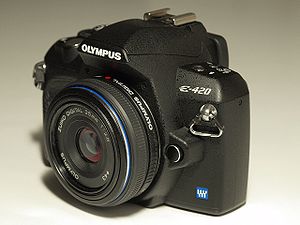
Advantages
- The smaller sensor size makes possible smaller and lighter camera bodies and lenses. In particular, the Four-Thirds system allows for the development of impressive f/2.0 zoom lenses, which would be prohibitively heavy, expensive, and difficult to design for larger sensor formats.
- Telecentric optical path means that light hitting the sensor is traveling perpendicular to the sensor, resulting in brighter corners, and most importantly improved off-center resolution, particularly on wide angle lenses.
- Because the flange focal distance is significantly shorter than most mounts (such as Canon FD, Canon EF, Nikon F and Pentax K), lenses for many other SLR types, including the old Olympus OM System, can be fitted to Four Thirds cameras with simple mechanical adapter rings. (Such mechanical adapter rings typically require manual setting of focus and aperture). In many cases this produces excellent results, especially with longer focal-length lenses and lenses at smaller apertures. A series of tests by John Foster (Using OM legacy lenses on E1 body) provides a demonstration.
- A smaller sensor can make it easier to achieve a deeper depth-of-field with a relatively larger aperture when needed, reducing the risk of out-of-focus photos. This effect does cut both ways however, leaving the photographer somewhat less in control of DOF (see disadvantage below).
Disadvantages
- Small sensors suffer from some compromises in image quality. Smaller pixels, to match the pixel count of larger chips leads to lower dynamic range. The sensor performance of Four Thirds remains reasonably close to APS-C. However, full-frame 35mm sensors—which are nearly 4x larger—outperform Four Thirds sensors by a wide margin.
- Because of the higher crop factorCrop factorIn digital photography, a crop factor is related to the ratio of the dimensions of a camera's imaging area compared to a reference format; most often, this term is applied to digital cameras, relative to 35 mm film format as a reference. In the case of digital cameras, the imaging device would be a...
, an image shot at a given relative aperture and angle of view has more depth of fieldDepth of fieldIn optics, particularly as it relates to film and photography, depth of field is the distance between the nearest and farthest objects in a scene that appear acceptably sharp in an image...
on Four Thirds. This results in less control over depth of field, compared to larger formats. For instance, a 35mm full frame DSLR can match the depth of field of a Four Thirds camera by closing down the aperture by two stops; but it may be more difficult or impossible for a Four Thirds system to match the shallow depth of field of a 35mm full frame camera with fast lenses. - Olympus may focus its future developments on Micro Four Thirds rather than Four Thirds.
Differences
- Most Four Thirds cameras (notably those manufactured by Olympus) use an aspect ratio of 4:3 rather than 3:2; newer models offer cropping to 3:2, but this results in a reduced image diagonal (i.e., the effective crop factor is then 2.08). However, some Four Thirds cameras offer shooting at different aspects (including 3:2) while maintaining the same diagonal angle, for example the Panasonic Lumix DMC-GH1Panasonic Lumix DMC-GH1The Panasonic Lumix DMC-GH1 is a digital mirrorless interchangeable lens camera adhering to the Olympus and Panasonic developed Micro Four Thirds System system design standard...
.
Four Thirds system companies
As of the 2006 Photo Marketing Association Annual Convention and Trade ShowPhoto Marketing Association Annual Convention and Trade Show
The Photo Marketing Association International International Convention and Trade Show is an annual imaging technology trade show conducted by PMA held in Las Vegas. The PMA International Convention and Trade Show frequently are the occasion for the public introductions of important imaging products...
, the Four Thirds consortium consists the following companies:
- FujiFujifilmis a multinational photography and imaging company headquartered in Tokyo, Japan.Fujifilm's principal activities are the development, production, sale and servicing of color photographic film, digital cameras, photofinishing equipment, color paper, photofinishing chemicals, medical imaging...
- KodakEastman KodakEastman Kodak Company is a multinational imaging and photographic equipment, materials and services company headquarted in Rochester, New York, United States. It was founded by George Eastman in 1892....
- Leica
- Olympus
- Panasonic
- SanyoSanyois a major electronics company and member of the Fortune 500 whose headquarters is located in Moriguchi, Osaka prefecture, Japan. Sanyo targets the middle of the market and has over 230 Subsidiaries and Affiliates....
- SigmaSigma Corporationis a Japanese company founded in 1961, manufacturing cameras, lenses, flashes and other photographic accessories. All Sigma products are produced in the company's own Aizu factory in Bandai, Fukushima, Japan...
This does not imply a commitment to end user products by each company. Currently only Leica, Olympus, and Panasonic have bodies. Olympus and Leica/Panasonic make dedicated Four Thirds lenses, and Sigma makes adapted versions of their "DC" lenses for APS-C format DSLRs. Kodak once sold sensors to Olympus for use in their Four Thirds bodies, but the newer Olympus Four Thirds cameras use Panasonic sensors.
Four Thirds system cameras
The majority of Four Thirds system cameras (and Four Thirds lenses) are made by Olympus. Many Four Thirds cameras use "sensor-shift" in-body image stabilizationImage stabilization
Image stabilization is a family of techniques used to reduce blurring associated with the motion of a camera during exposure. Specifically, it compensates for pan and tilt of a camera or other imaging device. It is used in image-stabilized binoculars, still and video cameras, and astronomical...
, making the need for image stabilization technology in its lenses unnecessary. All Four Thirds cameras also incorporate an automatic sensor cleaning device, in which a thin glass filter in front of the sensor vibrates at 30 kHz causing dust to fall off and adhere to a piece of sticky material below. Olympus' E-system camera bodies are noted for their inclusion of a wide range of firmware-level features and customization, good JPEG engine, and compact size. Because of the smaller format of Four Thirds, the viewfinders tend to be smaller than on comparable cameras.
- Olympus E-1Olympus E-1The Olympus E-1, introduced in 2003, was the first DSLR system camera designed from the ground up for digital photography. This contrasts with its contemporaries which offered systems based on reused parts from previous 135 film systems, modified to fit with a sensor size of APS-C.-Features:The E-1...
(November 2003) - Olympus E-300Olympus E-300The Olympus E-300 is an 8 megapixel digital SLR manufactured by Olympus of Japan and based on the Four Thirds System. Announced at Photokina 2004, it became available at the end of 2004...
(December 2004) - Olympus E-500Olympus E-500The Olympus E-500 is an 8 megapixel digital SLR camera manufactured by Olympus of Japan and based on the Four Thirds System. It was announced on 26 September 2005...
(September 2005) - Olympus E-330Olympus E-330The Olympus E-330 is a DSLR launched on 30 January 2006, using the Four Thirds System lens mount standard. Its main feature is its live image preview functionality, permitting an image to be previewed on the LCD screen. While live image preview is not new in compact digital cameras, the E-330 is...
(January 2006) - Panasonic Lumix DMC-L1Panasonic Lumix DMC-L1The Lumix DMC-L1 was Panasonic's first digital single-lens reflex camera, and was announced in February 2006. This camera adheres to the Four Thirds System lens mount standard, making it the first non-Olympus Four Thirds camera, and thus confirming that the Four Thirds System is a semi-open...
(February 2006) - Leica Digilux 3Leica Digilux 3The Digilux 3 is a digital single-lens reflex camera introduced by Leica on 14 September 2006. The Digilux 3 and the Panasonic Lumix DMC-L1 are identical cameras, using the Four Thirds standard lens mount and featuring a 7.5 Megapixels live view N-MOS sensor, but the Digilux 3 has improved firmware...
(September 2006) - Olympus E-400Olympus E-400The Olympus E-400 is a digital single-lens reflex camera launched by Olympus on 14 September 2006, using the Four Thirds System lens mount standard....
(September 2006) - Olympus E-410Olympus E-410The Olympus E-410 is a 10 megapixel digital single-lens reflex camera intended be the smallest and lightest DSLR on the market...
(April 2007) - Olympus E-510Olympus E-510The Olympus E-510 is a 10 megapixel digital single-lens reflex camera oriented to the "prosumer" or "hobbyist" market. Announced in March 2007 to succeed the E-500, it represents the first use of the new Panasonic MOS sensors instead of the Kodak CCD sensors that Olympus had used previously...
(June 2007) - Panasonic Lumix DMC-L10Panasonic Lumix DMC-L10The Lumix DMC-L10 is Panasonic's second digital single-lens reflex camera , a follow-up to the previous Lumix DMC-L1 model. It was announced in August 2007, and, like the Lumix DMC-L1, this model uses the Four Thirds System lens mount standard and contains some basic parts provided by Olympus...
(October 2007) - Olympus E-3Olympus E-3The Olympus E-3 was until 2011 Olympus Corporation's previous flagship camera, positioned as a professional DSLR camera. It is the successor to the Olympus E-1, which was launched in November 2003. The E-3, originally codenamed Olympus E-P1, was announced on 17 October 2007. The E-3, like the other...
(November 2007) - Olympus E-420Olympus E-420The Olympus E-420 is a 10 megapixel digital single-lens reflex camera made by Olympus. The camera conforms to the Four Thirds System standard, and together with its siblings in the E-4XX series it is marketed as the smallest DSLR in the world.-Features:As with the E-400 and E-410 before it, the...
(May 2008) - Olympus E-520Olympus E-520The Olympus E-520 is a 10 megapixel digital single-lens reflex camera. Announced in May 2008 to succeed the E-510, it adds face detection technology, auto focus Live preview, wireless flash capability and shadow adjustment technology...
(June 2008) - Olympus E-30Olympus E-30The Olympus E-30 is a Four Thirds System camera, sitting between the Olympus E-520 and the E-3 cameras in terms of size, weight, capabilities and price. It is sold in a kit with the Zuiko Digital ED 14–54mm f2.8–3.5 II lens....
(November 2008) - Olympus E-620Olympus E-620The Olympus E-620 is a Four Thirds digital single-lens reflex camera from Olympus announced February 24, 2009. It combines features of the E-420 , E-520 , and E-30 .-Features:The camera is marketed by Olympus as the world's smallest DSLR with built-in image stabilization...
(March 2009) - Olympus E-450Olympus E-450The Olympus E-450 is a 10 megapixel digital single-lens reflex camera made by Olympus and conforming to the Four Thirds System standard. E-450 was announced in March 2009, and shipping started in May the same year...
(March 2009) - Olympus E-5Olympus E-5The Olympus E-5 is Olympus Corporation's flagship camera, positioned as a professional DSLR camera. It is the successor to the Olympus E-3, which was launched on October 17, 2007. The E-5 was announced on September 14, 2010...
(September 2010)
Four Thirds system lenses
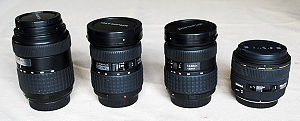
Lens mount
A lens mount is an interface — mechanical and often also electrical — between a photographic camera body and a lens. It is confined to cameras where the body allows interchangeable lenses, most usually the single lens reflex type or any movie camera of 16 mm or higher gauge...
is specified to be a bayonet
Bayonet mount
A bayonet mount or bayonet connector is a fastening mechanism consisting of a male side with one or more pins, and a female receptor with matching L slots and spring to keep the two parts locked together....
type with a flange focal distance
Flange focal distance
For an interchangeable lens camera, the flange focal distance of a lens mount system is the distance from the mounting flange to the...
of 38.67 mm.
There are currently around three dozen lenses for the Four Thirds system standard.
- Olympus produces about 20 lenses for the Four Thirds system under Zuiko Digital brand. They are divided into three "grades" (Standard, High Grade and Super High Grade). High Grade lenses have faster maximum apertures but are significantly more expensive and larger, and the Super High Grade zooms have constant maximum aperture over the full zoom range; all but the Standard grade are weather-sealed. Lenses within each grade cover the range from wide-angle to super telephoto. The Zuiko Digital lenses are well regarded for their consistently good optics. The following is a table of all current Zuiko Digital lenses:
| Wide angle | Standard | Telephoto | Super telephoto | Special-purpose | |
|---|---|---|---|---|---|
| Standard | 9–18 1:4–5.6 | 14–42 1:3.5–5.6 14–45 1:3.5–5.6 17.5–45 1:3.5–5.6 25 1:2.8 "pancake" |
40–150 1:3.5–4.5 40–150 1:4–5.6 |
70–300 1:4–5.6 macro | 35 1:3.5 macro 18-180 1:3.5-6.3 superzoom |
| High Grade | 11–22 1:2.8–3.5 | 12–60 1:2.8–4 14–54 1:2.8–3.5 |
50–200 1:2.8–3.5 | 50 1:2 macro 8 1:3.5 fisheye |
|
| Super High Grade | 7–14 1:4 | 14–35 1:2 | 35–100 1:2 150 1:2 |
90–250 1:2.8 300 1:2.8 |
- Olympus also makes 1.4× and 2× teleconverterTeleconverterA teleconverter is a secondary lens which is mounted between the camera and a photographic lens. Its job is to enlarge the central part of an image obtained by the objective lens...
s and an electronically-coupled extension tubeExtension tubeAn extension tube is an accessory for cameras with interchangeable lenses, used primarily for macro photography. The tube contains no optical elements; its sole purpose is to move the lens farther from the image plane. The farther away the lens is, the closer the focus, the greater the...
. - SigmaSigma Corporationis a Japanese company founded in 1961, manufacturing cameras, lenses, flashes and other photographic accessories. All Sigma products are produced in the company's own Aizu factory in Bandai, Fukushima, Japan...
has adapted 13 lenses for the Four Thirds system, ranging from 10 to 800 mm, including several for which no equivalent exists: the fast primes (30 mm and 50 mm ) and extreme telephoto (300–800 mm 5.6). - Leica has designed four lenses for the Four Thirds system: fast and slow normal zooms and a 14–150 mm super-zoom, all with Panasonic's image stabilization system, and an unstabilized 25 mm primePrime lensIn film and photography, a prime lens is either a photographic lens whose focal length is fixed, as opposed to a zoom lens, or it is the primary lens in a combination lens system....
. These are manufactured and sold by Panasonic.
An official list of available lenses can be found on Four-Thirds.org web site.
Micro Four Thirds system
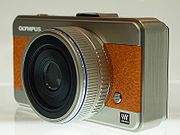
The new system uses the same sensor, but removes the mirror box from the camera design. A live view preview is shown on either the camera's main LCD or via an electronic viewfinder
Electronic viewfinder
An electronic viewfinder or EVF is a viewfinder where the image captured by the lens is projected electronically onto a miniature display. The image on this display is used to assist in aiming the camera at the scene to be photographed.-Operation:...
, as in digital compact cameras. Autofocus is accomplished via a contrast-detect process using the main imager, again similar to digital compact cameras. The goal of the new system is to allow for even smaller cameras, competing directly with higher-end point-and-shoot compact digital cameras and lower-end DSLRs. The smaller flange focal distance
Flange focal distance
For an interchangeable lens camera, the flange focal distance of a lens mount system is the distance from the mounting flange to the...
allows for more compact normal and wideangle lenses.
Four Thirds lenses can be used on Micro Four Thirds bodies with an adapter, however "all of the functions of the Micro Four Thirds System may not always be available."
See also
- Lenses for SLR and DSLR camerasLenses for SLR and DSLR camerasThis article is about photographic lenses for single-lens reflex film cameras and digital single-lens reflex cameras .Furthermore, the emphasis is on modern lenses for 35 mm film SLRs and for DSLRs with sensor sizes less than or equal to 35 mm .-Interchangeable lenses:The major advantage...
- Lens mountLens mountA lens mount is an interface — mechanical and often also electrical — between a photographic camera body and a lens. It is confined to cameras where the body allows interchangeable lenses, most usually the single lens reflex type or any movie camera of 16 mm or higher gauge...
- List of lens mounts
- Micro Four Thirds systemMicro Four Thirds systemThe Micro Four Thirds system is a standard created by Olympus and Panasonic, and announced on August 5, 2008, for mirrorless interchangeable lens digital cameras and camcorders design and development...
- Image sensor formatImage sensor formatIn digital photography, the image sensor format is the shape and size of the image sensor.The image sensor format of a digital camera determines the angle of view of a particular lens when used with a particular camera...
External links
- Official Four Thirds System site
- Four Thirds US patent 6,910,814; PDF version (1.7 MiB)
- Andrzej Wrotniak's pages about the Four Thirds System – includes a complete lens list
- Spanish site about the Four Thirds System
- Four Thirds User – independent site and user-community dedicated to the Four Thirds system, including Micro Four Thirds

